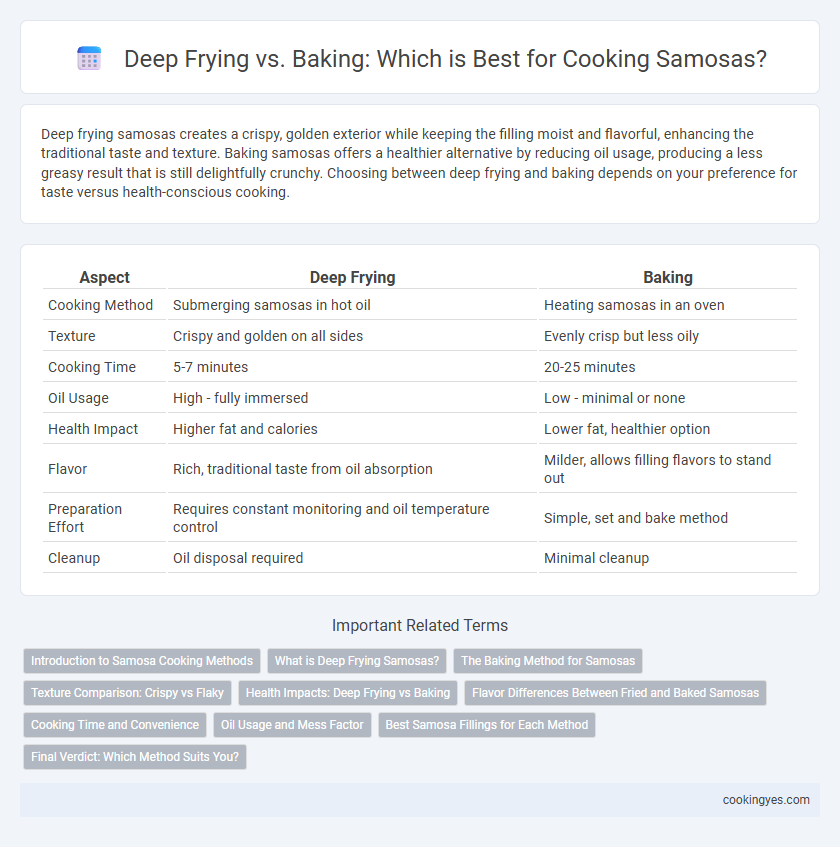Deep frying samosas creates a crispy, golden exterior while keeping the filling moist and flavorful, enhancing the traditional taste and texture. Baking samosas offers a healthier alternative by reducing oil usage, producing a less greasy result that is still delightfully crunchy. Choosing between deep frying and baking depends on your preference for taste versus health-conscious cooking.
Table of Comparison
| Aspect | Deep Frying | Baking |
|---|---|---|
| Cooking Method | Submerging samosas in hot oil | Heating samosas in an oven |
| Texture | Crispy and golden on all sides | Evenly crisp but less oily |
| Cooking Time | 5-7 minutes | 20-25 minutes |
| Oil Usage | High - fully immersed | Low - minimal or none |
| Health Impact | Higher fat and calories | Lower fat, healthier option |
| Flavor | Rich, traditional taste from oil absorption | Milder, allows filling flavors to stand out |
| Preparation Effort | Requires constant monitoring and oil temperature control | Simple, set and bake method |
| Cleanup | Oil disposal required | Minimal cleanup |
Introduction to Samosa Cooking Methods
Deep frying samosas creates a crispy, golden exterior with a rich flavor from the oil, ensuring the filling remains moist and flavorful. Baking samosas offers a healthier alternative by reducing oil content while still achieving a slightly crisp texture, although the crust tends to be less crunchy compared to deep frying. Choosing between these methods depends on dietary preferences, desired texture, and cooking equipment availability.
What is Deep Frying Samosas?
Deep frying samosas involves submerging them in hot oil at temperatures between 350degF to 375degF, resulting in a crispy, golden-brown exterior and a moist, flavorful filling. This cooking method ensures uniform heat distribution, creating the characteristic crunch and sealing in the spices and moisture inside. Deep frying is preferred for authentic texture and taste, though it increases calorie content compared to baking.
The Baking Method for Samosas
Baking samosas offers a healthier alternative to deep frying by significantly reducing oil absorption while maintaining a crispy texture. This method involves brushing samosas with oil and cooking them at 375degF (190degC) for 25-30 minutes, ensuring even browning and a golden crust. Baking also allows for easier preparation of large batches, making it ideal for health-conscious individuals seeking to enjoy traditional samosas without the added fat and calories.
Texture Comparison: Crispy vs Flaky
Deep frying samosas results in a crispy, golden-brown exterior that offers a satisfying crunch, enhancing the overall eating experience. Baking samosas creates a flaky, lighter texture with a slightly softer exterior, making them a healthier alternative without sacrificing taste. Texture preference depends on whether one desires a rich, crunchy bite or a delicate, layered crust.
Health Impacts: Deep Frying vs Baking
Deep frying samosas significantly increases their calorie and fat content due to oil absorption, leading to higher levels of unhealthy trans fats and saturated fats that can contribute to heart disease. Baking samosas reduces oil usage, resulting in lower fat content and fewer calories, making them a healthier option for maintaining weight and supporting cardiovascular health. Choosing baked samosas helps preserve essential nutrients while minimizing the intake of harmful compounds formed during high-temperature frying.
Flavor Differences Between Fried and Baked Samosas
Deep frying samosas creates a crispy, golden-brown exterior with rich, intense flavor due to Maillard reactions and the immersion in hot oil, which enhances the savory filling's taste. In contrast, baking samosas produces a lighter, less oily texture with a subtler flavor profile, allowing the spices and ingredients inside to stand out more delicately. While fried samosas offer a traditional, indulgent flavor experience, baked samosas provide a healthier alternative without sacrificing the essential spiced filling's aromatic qualities.
Cooking Time and Convenience
Deep frying samosas typically takes 5 to 7 minutes, resulting in a crispy, golden exterior, while baking requires 20 to 30 minutes but offers a healthier option with less oil. Deep frying demands constant attention and careful temperature control to avoid sogginess, whereas baking allows for hands-off cooking and easier cleanup, making it more convenient for busy kitchens. Choosing between these methods depends on the priority of quick, traditional texture versus time-efficient, health-conscious preparation.
Oil Usage and Mess Factor
Deep frying samosas requires a significant amount of oil, resulting in a crispy texture but increasing calorie intake and cleanup effort due to oil splatters. Baking samosas uses minimal or no oil, making it a healthier option with less mess and easier cleanup, though the texture tends to be less crispy compared to deep frying. Oil absorption is higher during deep frying, affecting both nutritional content and kitchen cleanliness, whereas baking offers a cleaner cooking process with reduced oil usage.
Best Samosa Fillings for Each Method
Deep frying samosas enhances the texture of fillings like spiced potatoes, peas, and minced meat, delivering a crispy and flavorful exterior that complements rich, moist interiors. Baking suits lighter fillings such as paneer, mixed vegetables, or cheese, offering a healthier alternative with a tender crust and subtle flavors. Selecting fillings with balanced moisture levels ensures optimal cooking results whether deep frying or baking samosas.
Final Verdict: Which Method Suits You?
Deep frying samosas delivers a crispy, golden exterior with a rich, indulgent flavor ideal for traditional taste preferences, while baking offers a healthier alternative by reducing oil consumption and calories. Choose deep frying for an authentic, crunchy texture and deep flavor, or opt for baking when prioritizing health and ease of cleanup without sacrificing much taste. Your decision depends on dietary goals and cooking convenience, balancing indulgence with nutrition.
Deep frying vs Baking for cooking samosas Infographic

 cookingyes.com
cookingyes.com